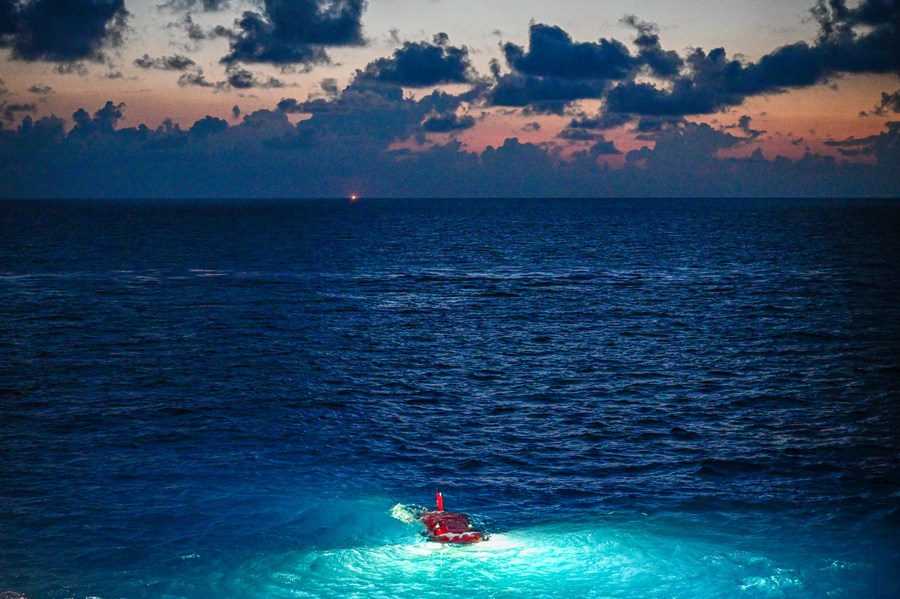
Editor's note: This is the third article of a series covering the discovery of two Ming Dynasty shipwrecks in the South China Sea. CGTN will write more about the topic according to the archaeological research progress. You can find the first and second piece here.
Hidden beneath 1,500 meters of seawater off the Chinese coast, a treasure trove of artifacts were unearthed by archaeologists last year.
During an October 2022 expedition, two shipwrecks were found on the floor of the South China Sea, containing a variety of precious relics.
Currently, researchers are examining the wreckage and have determined that one ship primarily carried porcelain for export, while the other was involved in importing wood. The relics are believed to belong to the Ming Dynasty (1368-1644).
A milestone for deep-sea archaeology
Experts consider this discovery groundbreaking as it combines advanced technological capabilities in marine archaeology with rigorous archaeological methods. China's deep-sea technology and underwater archaeology have made significant progress.
This is the first instance where rigorous archaeological methods combined with high-tech underwater equipment and platforms to investigate ancient shipwreck sites, according to the archaeology department of the National Cultural Heritage Administration (NCHA).
"The finding exemplifies the promising future of cross-disciplinary integration and the mutual progress between China's deep-sea technology and underwater archaeology," said Yan Yalin, director of the archaeology department of NCHA.
From the technical point of view, it was the first time for China to use manned deep-sea submersible vehicles at a depth of more than 1,000 meters, said Fan Jialing, deputy director of the Center of Museum Development and Research at Capital Normal University.
In the past, the underwater archeology work was mainly carried out in the coastal areas surrounding islands and reefs, reaching depths of approximately 30 meters below the surface, Fan said during an interview which CGTN.

The photo shows the interior of the No. 1 shipwreck near the northwest continental slope of the South China Sea, October 2022. Some 100,000 pieces of relics, mainly porcelain, were found in the ship. /Xinhua
The photo shows the interior of the No. 1 shipwreck near the northwest continental slope of the South China Sea, October 2022. Some 100,000 pieces of relics, mainly porcelain, were found in the ship. /Xinhua
The two well-preserved shipwrecks provide valuable information about ship-building technology during the Ming Dynasty. Additionally, they shed light on the historical importance of the Maritime Silk Road and its role in shaping global trade and cultural exchange.
Within one of the sunken ships, multiple clusters of cultural relics were discovered, suspected to be arranged within the vessel's cabin. The estimated collection, totaling around 100,000 items, primarily consists of porcelain scattered across a vast area spanning tens of thousands of square miles.
"It is likely that there will be other cultural remains apart from porcelains, maybe possible we can find organic cultural remains, which will provide information for us to study the social culture of this period, especially the details of life on the ship," Fan said.
The other ship revealed numerous logs of similar size. Some of the items discovered on this ship potentially date back to the reign of Emperor Hongzhi (1488-1505) of the Ming Dynasty. Based on initial assessments, it is presumed that this is an ancient shipwreck that transported goods from overseas to China.
This is the first instance where China has found ancient ships sailing and returning in the same sea area, confirming the importance and prosperity of this maritime trade route during that time, Fan said.

What is the plan for the next?
China's deep-sea archaeology has made remarkable strides in recent years. In April 2018 and August 2022, researchers conducted two deep-sea archaeological surveys in the waters of the Xisha islands. These expeditions led to the discovery of several shipwrecks and archaeological sites.
The ongoing research aims to evaluate preservation and protection methods for these shipwrecks, acknowledged for their "world-class archaeological importance." Extended research plans have been approved, scheduled to continue until April 2024.
On May 20, researchers of the deep-sea archaeological team started the first stage of investigation. They established a permanent underwater mapping foundation in the southwest corner of the shipwreck site and conducted preliminary searches. The first investigation phases will run from late May to early June this year.
To enhance and further the exploration efforts, China's research vessels Tansuo 1 and Tansuo 2, equipped with the submersible Fendouzhe, also known as Striver, will join the mission, according to Chen Chuanxu, a scientist at the Institute of Deep-sea Science and Engineering. With each new discovery made by the researchers, a clearer understanding of this ancient trade route is gradually unfolding.